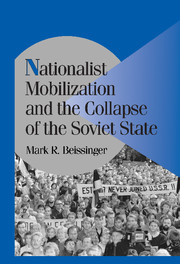Book contents
- Frontmatter
- Contents
- Illustrations
- Tables
- Acknowledgments
- 1 FROM THE IMPOSSIBLE TO THE INEVITABLE
- 2 THE TIDE OF NATIONALISM AND THE MOBILIZATIONAL CYCLE
- 3 STRUCTURING NATIONALISM
- 4 “THICKENED” HISTORY AND THE MOBILIZATION OF IDENTITY
- 5 TIDES AND THE FAILURE OF NATIONALIST MOBILIZATION
- 6 VIOLENCE AND TIDES OF NATIONALISM
- 7 THE TRANSCENDENCE OF REGIMES OF REPRESSION
- 8 RUSSIAN MOBILIZATION AND THE ACCUMULATING “INEVITABILITY” OF SOVIET COLLAPSE
- 9 CONCLUSION: NATIONHOOD AND EVENT
- Appendix I PROCEDURES FOR APPLYING EVENT ANALYSIS TO THE STUDY OF SOVIET PROTEST IN THE GLASNOST' ERA
- Appendix II SOURCES FOR THE COMPILATION OF EVENT DATA IN A REVOLUTIONARY CONTEXT
- Index
- Titles in the series
Appendix II - SOURCES FOR THE COMPILATION OF EVENT DATA IN A REVOLUTIONARY CONTEXT
Published online by Cambridge University Press: 18 November 2009
- Frontmatter
- Contents
- Illustrations
- Tables
- Acknowledgments
- 1 FROM THE IMPOSSIBLE TO THE INEVITABLE
- 2 THE TIDE OF NATIONALISM AND THE MOBILIZATIONAL CYCLE
- 3 STRUCTURING NATIONALISM
- 4 “THICKENED” HISTORY AND THE MOBILIZATION OF IDENTITY
- 5 TIDES AND THE FAILURE OF NATIONALIST MOBILIZATION
- 6 VIOLENCE AND TIDES OF NATIONALISM
- 7 THE TRANSCENDENCE OF REGIMES OF REPRESSION
- 8 RUSSIAN MOBILIZATION AND THE ACCUMULATING “INEVITABILITY” OF SOVIET COLLAPSE
- 9 CONCLUSION: NATIONHOOD AND EVENT
- Appendix I PROCEDURES FOR APPLYING EVENT ANALYSIS TO THE STUDY OF SOVIET PROTEST IN THE GLASNOST' ERA
- Appendix II SOURCES FOR THE COMPILATION OF EVENT DATA IN A REVOLUTIONARY CONTEXT
- Index
- Titles in the series
Summary
Most event analyses of mobilizational cycles have been conducted within a West European or North American context. Constructing event data for a revolutionary context like the Soviet Union during glasnost' presents problems different from those found in relatively more open polities or those in which the national frame of the state is not under open contestation.
The USSR was a polity which had experienced massive violent repressions and extensive restrictions on freedom of expression. In the period prior to glasnost', police records could be expected to reflect the mentality and biases of a security apparatus charged with extirpating all acts of dissidence, although an apparatus which ultimately failed in its mission. Moreover, in the aftermath of regime change these records themselves have been at the center of controversy, since they could be utilized as weapons for political compromise and intrigue (not to mention their continued security value to postcommunist governments). Party archives have been opened throughout much of the former Soviet Union, but for the most part KGB and police records covering the post-Stalin period have not. By the end of 1990 Soviet researchers working with the USSR Ministry of Internal Affairs were provided with daily reports on major acts of mass protest; these reports covered a small part of the mobilizational cycle, were usually presented in index form, and failed to differentiate between types of events. Only in the city of Minsk were independent scholars provided access to the local police records of protest actions – though Minsk was not a major site of the nationalist upheavals that overtook the Soviet Union.
- Type
- Chapter
- Information
- Nationalist Mobilization and the Collapse of the Soviet State , pp. 472 - 488Publisher: Cambridge University PressPrint publication year: 2002

